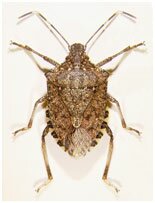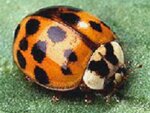The brown marmorated stink bug: Getting ready for a potentially serious pest
It’s a serious threat
Midwest farmers are faced with another harmful pest from Asia, the brown marmorated stink bug (BMSB). Its name describes its color pattern (marmorated, meaning marble-like or speckled) on its shield-like back, and what it smells like if it’s threatened or squished. However, its name does not tell the story of how this new pest is devastating parts of North America.
Over the past decade, the BMSB has moved into homes, fields and orchards in 33 states. It has a wide host range similar to Japanese beetle, including corn, soybean, fruits and vegetables. The BMSB is serious threat to agriculture and is wide-spread in the Eastern United States with additional known populations in California and Oregon. However, because of the BMSB’s recent detection in the Midwest, a thorough survey for this pest has not been conducted.
One thing is for certain, though: BMSB can take a toll on soybeans, although so far yield loss has been limited to the east coast. The insect, which is distinguished by white banding on the antennae and legs, a striped abdomen and a pale underside, tends to feed on soybean seeds through the pod, damaging the yield potential. During seed formation, BMSB can puncture tissue and cause deformations. The seed coat can be damaged, and overall the seeds are smaller and shriveled.
And while BMSB feeding appears to slow or delay development of soybeans, the insect’s appetite goes far afield. Corn is on its menu too. So are fruits and vegetables. In fact, there’s little it doesn’t attack with vigor, piercing and sucking leaves, stems, fruits, and seeds.

From left: adult brown marmorated stink bug (pest); green stink bug nymph (pest); adult and nymph brown stink bug (pest); and adult spined soldier bug (beneficial).
Scouting will reveal the presence of many species of stink bugs. While most stink bugs are herbivores, one sticks out as beneficial – that is, the BMSB’s cousin, the spined soldier bug, commonly found in Midwest soybean fields. Both the immature and adult stink bugs of this species are predatory, and will kill many soybean pests.
The entire agricultural sector is on a steep learning curve, working towards an integrated pest management program to control the BMSB. That’s a real challenge, because it’s different on so many levels.
- Like another invasive pest, the multi-colored Asian lady beetle, the BMSB isn’t limited to the field. It survives the winter as an adult by entering houses and structures, and becoming a noxious pest.
- Both the immature stage (nymphs) and adults feed on host plants.
- Generations overlap and can feed throughout most of the summer.
- Treatment thresholds have not been developed.
It’s unlikely that BMSB will show up in great numbers in soybean fields across the Midwest this summer. It usually takes two to three years to become problematic once it is introduced. They usually become problematic first in fruit trees and vegetables. It is possible, that in the Midwest, they may target corn and soybean early in the summer because of the low abundance of other hosts. Scouting will prove or disprove that prediction.
If you find stink bugs in your soybean or corn fields, and you are not certain which species you have, contact your state’s Extension entomologist. They will assist you in accurately identifying the insect and providing options for management.

